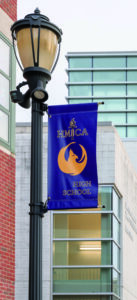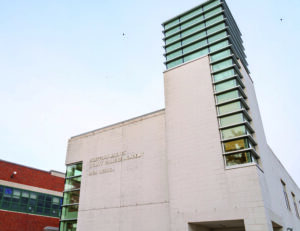Getting a jump on the college experience
Partnership puts HMTCA students in Trinity classes
Story by Andrew J. Concatelli
Photos by Nick Caito
“A lot of colleges offer college credit to high school students, but having a student actually go to the campus and be in the classroom with college students is something special.”
So says Kareen Wilson, mother of Bryana Wilson, a senior at Hartford Magnet Trinity College Academy (HMTCA) who takes classes at Trinity College. Bryana Wilson was among the 21 high school students who enrolled in a Trinity course during the fall 2023 semester thanks to the Early College Program, part of the long-standing partnership between Trinity and HMTCA, the public middle and high school that stands just across Broad Street from the College.

“I think that experiencing what it’s like to be on a college campus prepares you a little more for when you go off to college on a full-time basis,” Kareen Wilson adds. “There’s no hand-holding, and you have to ask questions and interact. I think the experience built Bryana’s confidence a lot. Trinity’s a great school, so she knows that if she can thrive there, she can succeed anywhere.”
The Trinity-HMTCA partnership began in 2011, when Hartford Magnet Middle School was renamed and expanded to include high school grades. The Hartford Board of Education and the Trinity College Board of Trustees signed a memorandum of understanding to develop a relationship that would benefit both institutions. The Early College Program is just one part of this effort [see below].
Stefanie Chambers, John R. Reitemeyer Term Professor of Political Science, was the first director of the partnership, followed by Robert Cotto Jr., now Trinity’s director of DEI campus and community engagement. Today, Liliana Polley IDP’21, M’23, has oversight as the director of Trinity’s Center for Hartford Engagement and Research (CHER) strategic partnerships.
“Being engaged with HMTCA and its students shows Trinity’s commitment to the community. This partnership connects directly with the vision and mission of the College, which values its place in Hartford,” Polley says. “The idea is to expose high school students to a college campus, to provide them access to Trinity’s resources, and to show them how to thrive in a college setting, fully participate in a college classroom, and develop personal responsibility by partnering with others to increase their academic success.”
Select Trinity courses are offered to HMTCA students at no cost to their families; Hartford Public Schools pays a small tuition fee. In addition, Polley says, it is free for any HMTCA student to apply to Trinity as a regular matriculated student, and Trinity offers a $50,000 Paul E. Raether Scholarship every four years to one HMTCA student who is accepted to Trinity.
 To apply to take Trinity courses through the Early College Program, HMTCA students need a GPA of 3.0 or higher and a letter of recommendation from a teacher. Applicants select up to three courses from among those offered, ranked by preference, and Polley works with HMTCA guidance counselors and Trinity faculty to match the students and courses based on their preferences, seat availability, and schedules. HMTCA students usually take one Trinity course per semester.
To apply to take Trinity courses through the Early College Program, HMTCA students need a GPA of 3.0 or higher and a letter of recommendation from a teacher. Applicants select up to three courses from among those offered, ranked by preference, and Polley works with HMTCA guidance counselors and Trinity faculty to match the students and courses based on their preferences, seat availability, and schedules. HMTCA students usually take one Trinity course per semester.
All students go through an orientation, where they receive a Trinity ID and learn how to access Trinity resources, including the Writing Center and the Aetna Quantitative Center, and how to get around campus. Math students must first take a math placement exam.
“The HMTCA students will sign out of their school, come to campus, attend their Trinity class, and go back,” Polley says. “Students become very independent and are responsible for getting to class on time, taking notes, and being on top of their assignments.”
This year, Polley began hiring Trinity student mentors to help guide the high schoolers as they adapt to college work. Tanetta E. Andersson, senior lecturer in sociology at Trinity, teaches courses in which the high school students may enroll, and she has seen firsthand the connections Trinity and HMTCA students form.
“To optimize students’ learning, I networked with their Trinity student tutors, Jessica Cruz ’26 and Demi Janis ’24,” Andersson says. “Before they met with HMTCA students in one-on-one meetings, we communicated about their progress and questions and strategized about strengthening their note-taking and exam preparation.”
In addition to the mentors, Andersson says, other Trinity students have helped to make their HMTCA peers feel welcome in her class. “Trinity students stayed after class to join in smaller group discussions and a lunch hangout session with HMTCA students,” she says. “Relaxing in the dining hall with their classmates and tutors, they exchanged college application stories, studying tips, and how they’ve adjusted to campus life and living away from home.”
Andersson adds that HMTCA students are strong contributors to class discussions and group work. “I am very proud of their level of engagement and the learning connections built through the Early College Program,” she says. “One of the senior high school students really excelled and is now a first-year student at Trinity.”
really excelled and is now a first-year student at Trinity.”
HMTCA school counselor Sonia Tamburro Pastormerlo agrees that the Early College Program helps prepare students for challenges they may face at college. “They’ll know what to expect, what a college lecture looks like, and how to reach out to a professor if they need help,” she says. “Advocating for yourself is a huge lesson that they learn.”
Tamburro Pastormerlo adds that her school’s students enjoy learning about subjects that may not be taught at HMTCA. “I hope we continue to expand the course offerings that students choose from as more professors see what our students are capable of,” she says.
Polley plans to add to both the number of courses available through the program and the number of HMTCA students enrolled. “I create a catalog of available courses based on connections with professors and the support of willing departments. The Mathematics Department is especially supportive of HMTCA students who qualify for their courses via a math placement test. In fall 2023, students were able to choose from 29 courses from across the curriculum, which tripled from last year,” she says. Last fall marked a record-high enrollment for the program, but as Polley says, “The goal is not to increase numbers but to make sure the students who are here are successful.”
Kareen Wilson notes, “As more HMTCA students get a chance to experience Trinity College, it’s a benefit for both schools. The partnership is heading in a great direction, and I would love to see it expand.”
Trinity + HMTCAThe partnership’s numerous initiatives create meaningful educational connections between Hartford Magnet Trinity College Academy and Trinity College. COURSES AT TRINITYQualified HMTCA students take Trinity courses as part of the Early College Program, and all seniors take HMTCA English courses in a dedicated classroom on Trinity’s campus. SUMMER WRITING INSTITUTEHMTCA students take a college preparatory writing course taught by Trinity professors. TRIN-HMTCA TUTORSA new after-school program connects HMTCA students with Trinity tutors and mentors. LUNCH PROGRAMHMTCA students join Trinity student leaders from the Men of Color Alliance and the Office of Multicultural Affairs for a monthly conversational lunch at a Trinity dining hall. TRINITY COURSE PARTNERSHIPSAs part of their coursework, Trinity students partner with HMTCA teachers in courses such as “Analyzing Schools” and “Classical Civilization in Community.” |
